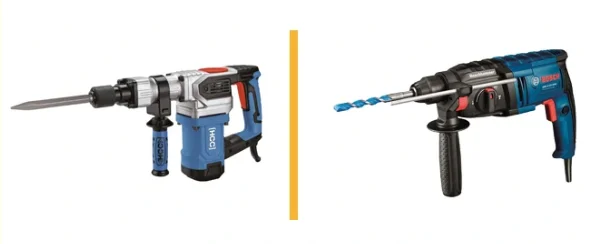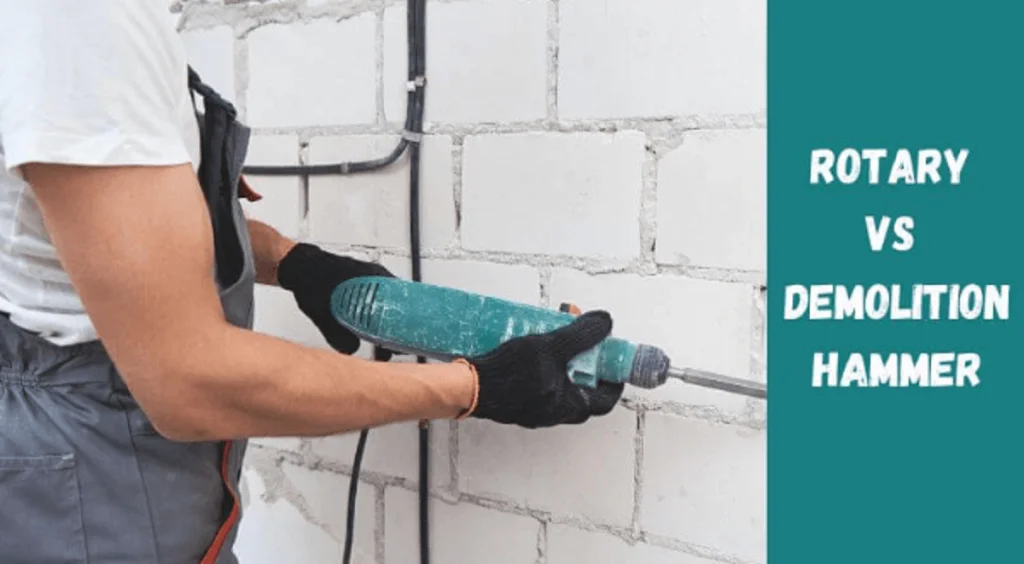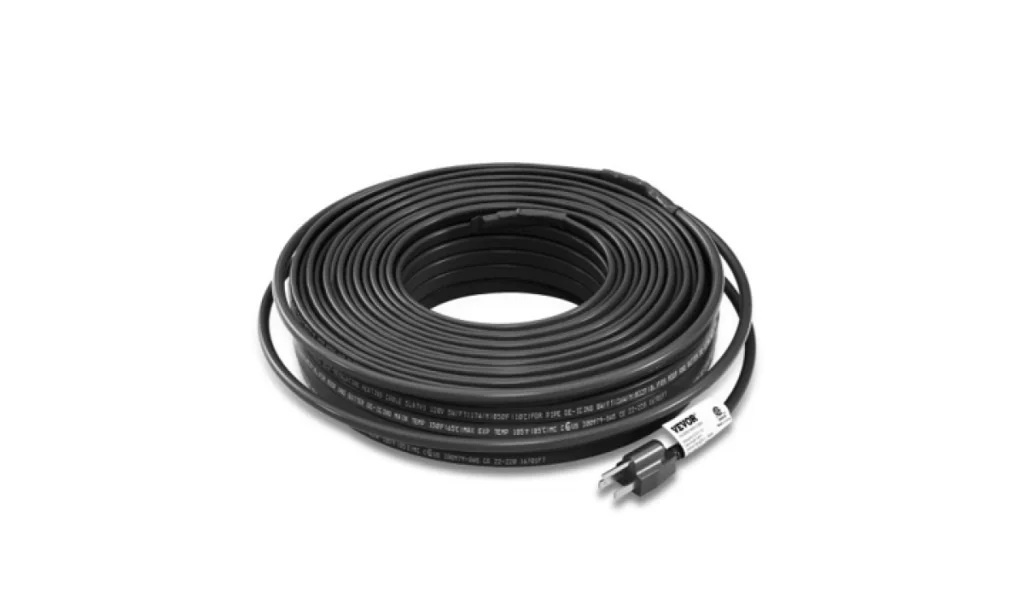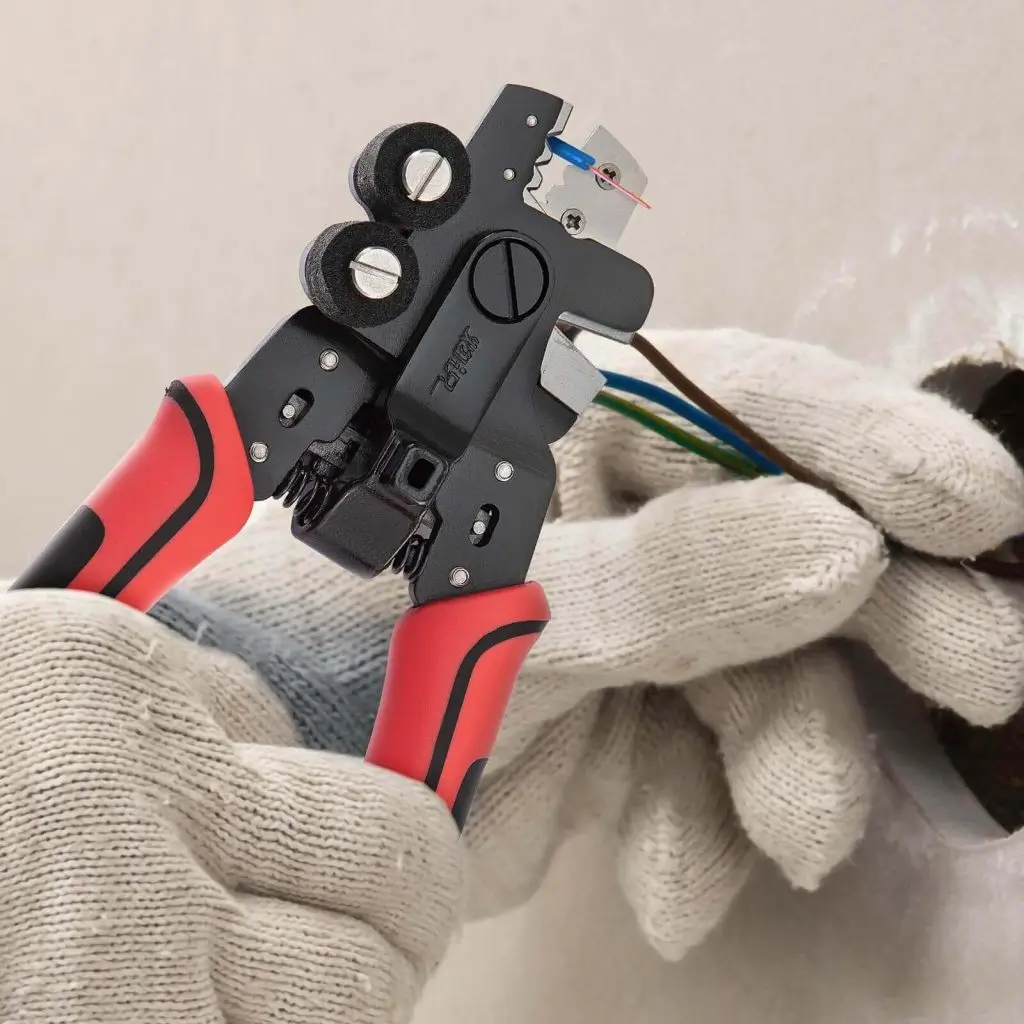In the world of construction and renovation, the choice of the right tools can be the differentiating factor between a project’s success and its challenges. Two heavyweights in the world of power tools, the demolition hammer and the rotary hammer, often find themselves at the forefront of discussions among professionals and DIY enthusiasts alike. While both tools share a common goal of breaking through tough materials, they possess distinctive features tailored to specific applications.
In this guide, we will decode the distinctions between these two powerful tools, shedding light on their unique characteristics, applications, and the scenarios in which they excel.
Whether you’re figuring out demolition hammer vs rotary hammer or weighing the differences between a rotary hammer drill and demolition hammer, this guide is here to give you a clear understanding of these powerful tools.
Let’s get started!
Table of contents
- Rotary Hammer Drill vs. Demolition Hammer: Understanding the basics
- How Are Demolition Hammers and Rotary Hammers Different
- Precision vs. Force
- Pros and Cons Comparison
- Common Concerns and Considerations
- Making the Right Choice: Factors to Consider Between Demolition Hammers and Rotary Hammers
- Why Choose VEVOR Demolition Hammers?
- Last Words
Rotary Hammer Drill vs. Demolition Hammer: Understanding the basics
Rotary Hammer
A rotary hammer is a robust and versatile power tool designed for drilling into hard materials like concrete, stone, or masonry. It operates on a principle that combines the rotary motion of a drill with a pulsating hammering action, providing a powerful and efficient means of breaking through tough surfaces. Unlike traditional drills, rotary hammers are equipped with a piston mechanism that generates rapid and short hammering blows as the bit rotates.
Key Functions and Applications
- Excels in drilling holes in challenging materials.
- Hammering action allows for faster drilling and effective penetration into dense substances.
- Valuable in tasks such as installing anchors, creating holes for pipes, and other construction activities.
- Particularly suited for projects where precision and power are paramount.
- Offers versatility with various settings, allowing users to switch between drilling, hammer drilling, and chiseling modes.
Demolition Hammer
A demolition hammer, on the other hand, is a heavy-duty power tool explicitly designed for breaking and demolishing concrete, brick, or other hard materials. Unlike rotary hammers, demolition hammers focus solely on delivering a powerful hammering action without the rotating drilling motion. They typically feature a pneumatic or hydraulic hammer mechanism that efficiently transfers energy to a chisel or point, enabling the tool to break apart and remove stubborn materials.
Key Functions and Applications
- Indispensable in tasks involving the removal of concrete structures, breaking up foundations, or demolishing walls.
- High-impact blows make them highly effective for chipping away concrete or masonry with precision and force.
- Preferred by construction professionals for projects requiring controlled destruction of existing structures.
- Specialized for heavy-duty demolition work.
- Offers unmatched power and efficiency in breaking down solid structures.
- The absence of a drilling motion focuses on powerful hammering action for demolition tasks.
How Are Demolition Hammers and Rotary Hammers Different
The distinction between demolition hammers vs rotary hammers lies in their fundamental design and intended applications. Understanding these key differences is pivotal for users seeking the right tool to meet the demands of their specific projects.

Power and Impact
Rotary hammers are distinguished by their impressive power, measured in terms of impact energy. Impact energy is a critical factor influencing drilling efficiency. These hammers employ a combination of rotary motion and pulsating hammering action, resulting in a high-impact force delivered to the drilling surface. The impact energy determines the tool’s ability to penetrate challenging materials like concrete and masonry, making rotary hammers particularly efficient in drilling tasks.
Demolition hammers, on the other hand, are designed for sheer power, especially when it comes to breaking tough materials. They boast higher impact energy, a characteristic essential for the controlled destruction of concrete structures. The increased impact energy enables demolition hammers to deliver forceful blows, making them indispensable for tasks that demand significant power, such as breaking up foundations or demolishing walls.
Versatility in Applications
Rotary hammers showcase versatility in their applications, making them suitable for a wide range of tasks. Their primary strength lies in drilling into tough materials like concrete and masonry. Additionally, these hammers are adept at handling various tasks beyond drilling, such as hammer drilling and chiseling. This versatility makes rotary hammers indispensable on construction sites where different applications may be required.
On the contrary, the primary focus of demolition hammers is on breaking and chiseling tasks. Their design, emphasizing high-impact blows, aligns with the requirements of heavy-duty demolition work. While they might lack the drilling versatility of rotary hammers, demolition hammers excel in precision when it comes to the controlled destruction of existing structures.
Precision vs. Force
Rotary hammers offer a high level of precision, especially in drilling tasks. The combination of rotary motion and controlled hammering allows for accurate hole starting and finishing. This precision is crucial in applications where accuracy is paramount, such as installing anchors or creating holes in pipes.
Demolition hammers, with their emphasis on force, provide unmatched power in breaking down solid structures. While they might lack the precision of rotary hammers in drilling, their forceful blows make them ideal for projects where controlled destruction of existing structures is the primary objective.
Understanding these distinctions in power, versatility, and the balance between precision and force is crucial for selecting the right hammer for specific tasks, ensuring optimal performance and efficiency on the job site.
Pros and Cons Comparison
| Criteria | Rotary Hammer | Demolition Hammer |
|---|---|---|
| Pros | Versatile applications for drilling, hammer drilling, and chiseling. | High-impact blows for effective breaking and chiseling. |
| Precise drilling with the ability to start and finish holes accurately. | Unmatched power and efficiency in demolishing structures. | |
| Suitable for various construction and renovation projects. | Ideal for heavy-duty demolition work. | |
| Variable speed and settings enhance adaptability on the job site. | Effective for controlled destruction of concrete structures. | |
| Cons | Limited to drilling and related applications. | Lack of versatility for drilling tasks. |
| Smaller impact energy compared to demolition hammers. | Can be heavier and bulkier, limiting maneuverability. | |
| May struggle with extremely tough materials. | Less precision in drilling compared to rotary hammers. |
Common Concerns and Considerations
Task Specificity
Concern: Users need to consider the specific tasks they will be performing.
Consideration: Choose a rotary hammer for versatile applications and precise drilling or a demolition hammer for focused, high-impact breaking tasks.
Weight and Maneuverability
Concern: The weight and bulkiness of the tool can affect user fatigue and maneuverability.
Consideration: Assess the weight of the hammer, especially for prolonged use, and consider ergonomic features for enhanced comfort.
Material Compatibility
Concern: Different materials require specific tools for optimal performance.
Consideration: Evaluate the material you’ll be working with and select the hammer that suits the hardness and demands of the task.
Power Requirements
Concern: Power sources and energy consumption may vary.
Consideration: Check power requirements, whether corded or cordless and ensure compatibility with the job site conditions.
Cost Considerations
Concern: Budget constraints may influence the choice between rotary and demolition hammers.
Consideration: Evaluate the overall cost, considering the initial investment, maintenance, and potential savings in time and labor.
Noise and Vibration Levels
Concern: High noise and vibration levels can impact user comfort and safety.
Consideration: Look for hammers with features that minimize noise and vibration, promoting a safer and more comfortable working environment.
Making the Right Choice: Factors to Consider Between Demolition Hammers and Rotary Hammers
Choosing between a demolition hammer vs rotary hammer involves a thoughtful consideration of several factors, each playing an essential role in ensuring the tool aligns seamlessly with the demands of the project. Here are the key factors to weigh when making this critical decision:
Project Type and Scope
Demolition Hammer
Opt for a demolition hammer if the project involves significant demolition work, such as breaking down concrete structures, removing foundations, or demolishing walls. The high-impact blows of a demolition hammer excel in heavy-duty tasks requiring substantial force.
Rotary Hammer
Choose a rotary hammer for projects that demand versatility, including drilling into challenging materials like concrete and masonry. If the scope involves a combination of drilling, hammer drilling, and chiseling, the rotary hammer’s multifunctionality becomes advantageous.
Material Hardness
Demolition Hammer
Ideal for extremely tough and dense materials. If the primary challenge is breaking through hardened concrete or masonry, the demolition hammer’s powerful hammering action is well-suited for the task.
Rotary Hammer
Suited for tasks where drilling precision in hard materials is essential. The rotary hammer’s combination of rotary and hammering action allows for efficient drilling on challenging surfaces.
Precision Requirements
Demolition Hammer
When precision is less critical, and the focus is on controlled destruction, a demolition hammer is the tool of choice. It delivers forceful blows for effective material removal without the need for precise drilling.
Rotary Hammer
Optimal for tasks where both power and precision are crucial. The rotary hammer’s ability to drill with accuracy makes it suitable for applications like installing anchors or creating holes for pipes.
Versatility Needs
Demolition Hammer
If the project predominantly involves demolition and breaking tasks, and versatility is secondary, a demolition hammer is a more specialized and efficient choice.
Rotary Hammer
Choose a rotary hammer if the project requires a tool that can seamlessly transition between drilling, hammer drilling, and chiseling modes. Its adaptability makes it well-suited for a variety of construction applications.
User Comfort and Control
Demolition Hammer
Suited for users who prioritize power and efficiency in demolition work. The absence of a drilling motion allows for a straightforward and focused approach to breaking down materials.
Rotary Hammer
Ideal for users who require a balance between power and precision. The rotary hammer’s ability to drill accurately and switch between modes offers a more versatile and controlled user experience.
Tool Portability and Size
Demolition Hammer
Often heavier and bulkier, designed for heavy-duty applications. Consider the tool’s weight and size to the accessibility of the work area and the user’s physical capabilities.
Rotary Hammer
Generally more compact and lighter, making it suitable for projects where portability is a consideration. This factor is crucial for tasks in confined spaces or projects that require frequent tool movement.
The decision between a demolition hammer and a rotary hammer hinges on a comprehensive evaluation of project requirements, material characteristics, and user preferences. By considering these factors thoughtfully, users can make an informed choice that optimizes efficiency, precision, and overall project success.
Why Choose VEVOR Demolition Hammers?

VEVOR, a trusted name in the industry, offers a compelling choice with its range of demolition hammers. Here are the key considerations that make VEVOR Demolition Hammers a preferred option:
Superior Performance & Top Quality
VEVOR demolition hammers are meticulously designed for professional use, featuring heavy-duty aluminum construction that ensures exceptional durability and corrosion resistance for sustained, long-term performance.
Reassuring Experience
The high-strength alloy chuck is engineered to withstand the robust impact of demolition operations, providing a reliable and secure grip. The chipping hammer chuck facilitates quick and easy assembly and disassembly, ensuring hassle-free replacement of chisels without the risk of accidental drops. The handle, constructed from insulating plastic, prioritizes user safety by minimizing electric shock hazards.
Designed To Go Above And Beyond
VEVOR goes the extra mile with an upgraded shock absorption structure, incorporating double springs to alleviate user effort during operation. The 360°rotary handle not only reduces fatigue during prolonged work but also enhances accuracy and precision in confined spaces. The inclusion of a suitcase adds to the tool’s convenience for portability, and the locking button ensures automatic maintenance of operation, further saving user effort.
Stays Cool During Intense Work
VEVOR’s demolition hammers are equipped with an efficient cooling system that actively cools the motor, contributing to an extended lifespan of the concrete breaker. Even during prolonged periods of intense work, the engine maintains low temperatures, ensuring consistent and reliable performance.
Wide Range of Applications
The 110V VEVOR Demolition Jack Hammer comes with a versatile set of 6 chisel bits, including pointed chisel, flat chisel, clay spade chisel, flat spade chisel, scraping chisel, and big scraping chisel.
This diversity makes it perfect for a multitude of applications, such as demolition, trenching, chipping, and hole-breaking in concrete, block, brick, and tile. Its adaptability extends to various construction scenarios, including pipeline work, mechanical installations, drainage facilities construction, housing foundation removal, concrete slab tasks, oil chimney projects, interior decoration, and much more.
VEVOR demolition hammers stand out with their superior performance, thoughtful design features, and versatility, making them the ideal choice for professionals seeking reliable and efficient tools for a wide array of demanding applications.
Last Words
Decoding the distinctions between demolition hammers vs. rotary hammers has unraveled the key differences that can significantly impact your construction or renovation projects. Understanding the nuances between a rotary hammer drill and vs. demolition hammer allows for informed decision-making based on the specific demands of the task at hand. For those seeking reliable tools that embody performance and precision, consider exploring VEVOR’s range of demolition hammers. From heavy-duty demolition to precise drilling, VEVOR’s commitment to quality ensures you have the right tool for the job.





